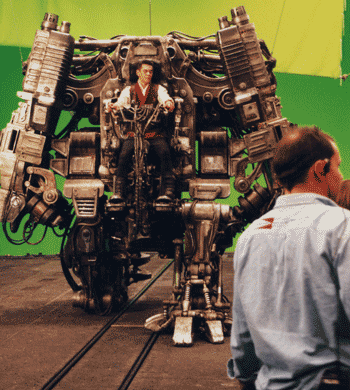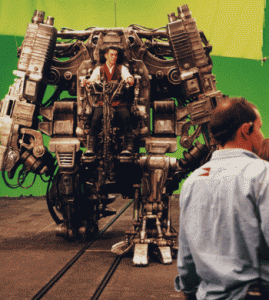
 Archival interview with Martin Crowther from the official Matrix website.
Archival interview with Martin Crowther from the official Matrix website.
BACKGROUND
MATRIX: Where does your experience lie?
MARTIN: Most of my experience is in animatronics – small little furry creatures or lizards or whatever – but the animatronics world isn’t that big in Australia and if I was only to do animatronics I’d be out of work most of the time. So I make mechanical rigs, gadgets, props, whatever anybody wants basically, from mechanical hands to little cuddly koalas. And I would say ninety percent of what I do is for film.
MATRIX: Where does your engineering background come from?
MARTIN: Before I emigrated here, which was twelve years ago, my background was engineering in the oil and gas industry in England. So the APU isn’t as daunting to me as it might be to you. It’s really quite simple to make; it’s just impressive to look at.
MATRIX: What are some other projects you’ve worked on?
MARTIN: Commercials, which were animatronic based as well, like koalas for the QANTAS commercials and that sort of thing. The first MATRIX, Mission: Impossible II, Red Planet, Star Wars: Episode II – Attack of the Clones, and a little kids’ film called Ozzie that I finished in New Zealand before I started on this one. I worked on Komodo, where I built some four meter lizards, which was shot in Queensland, and a couple of pieces for Queen of the Damned – a mechanical hand and a heart.
MATRIX: How did you get involved on the original MATRIX film?
MARTIN: I worked in the Models and Miniatures and Props Department, staring half way through the production, so I didn’t do the whole film. I became involved mainly because of my engineering background – most of the things I do that aren’t animatronic are things like mechanisms for chairs, and lifting arms and things like that. In the Nebuchadnezzar each chair has its own pneumatic operated arm with monitors on where the jacks come from – I built those and a few other props like lights. The thing with the chairs is that most people don’t actually notice the chairs unfortunately, because they’re more concerned with the actors that are in them or things that are going around – they don’t get a chance to get a good look at the chairs. They’ve reused that pneumatic arm in the sequels as well.
MATRIX: Do you remember your reaction when you got the call to do the sequels?
MARTIN: It’s always nice to do these films – big budget films are nice to work on because of the money and the input that’s there, so you get the chance to do a nice job. Sometimes if the budget is a little bit tight things get shortcut.
MATRIX: What are some other projects that you’ve worked on, on the sequels?
MARTIN: At the moment I’m in the process of making a watch for some close-up shots, and I had to make some lipsticks earlier on. There’s also a shot of a key going into a lock for a close-up and I made that mechanism. I have done some bullets for the CG work and I’ve overseen a few of the other projects as well, like the ammo box hoist lifter.
THE APU
MATRIX: The APU alone is a massive undertaking, and is just one part of this production.
MARTIN: Yes, I’ve been told that it’s probably one of the biggest props that has actually been made in Australia that is a mechanical prop, in as much as it works. I don’t know how true that is, but it’s pretty big to me – four and a half meters tall [14.8 feet]. I started on this project in April 2001, which is over fourteen months ago. The first thing I built at that stage was one of the guns, and then the APU itself kicked in around about June 2001, and we’ve been on it ever since.
MATRIX: Initially, did you anticipate the scale of the APU?
MARTIN: No, not until a couple of months in when the storyboards started getting dished out and we actually saw what we were getting into. Some of the first things we saw were the Geof Darrow [Conceptual Designer] sketches, and at that time I think Sergei [Chadiloff, CAD Computer Modeler] was in the process of converting Geof’s drawings into a 3D model, which we then had to interpret and correct anything to make it work at the end of that.
The process was that we had Geof’s artististic impressions that Sergei then converted into a 3D model as closely as he could, keeping to the original design. From that 3D model we then got drawings of most of the components and where they are in relation to each other. From that my main job was to make sure that the legs could move, the knees could pivot, all the shocks moved, and that he could twist at the waist and arms and all those sorts of joints. Inside the APU is a steel armature, and on that steel armature we’ve got all the pivot points and all the shafting – everything that it takes to support its own weight – then Adam [Grace, APU Foreman] came along and made all the dressing pieces. It really is a team effort; I make the inside skeleton and he has skinned it. The detail factor on the outside – what you actually see aesthetically – has to be made as good as possible. You make it pristine and then it gets cut back with all the aging because nobody knows at the early stage just what it’s going to be like.
MATRIX: Why did it have to be made in such a solid way?
MARTIN: Because it had to be able to support its own weight, otherwise it would’ve had to have lots of props or cables supporting it. We also have to remember the actors and people are climbing up and acting on it, so whatever else it has to be strong enough to support them. We don’t want any actors getting damaged, obviously, so that’s the main reason for its strength. Basically we can climb all over this, and we won’t damage a panel or anything because it has all been foam filled and everything.
MATRIX: What was the time scale?
MARTIN: This whole thing could quite easily be built in six months without any problem, but all the way along the line – as it is in the movies – things get changed and decisions have to be made so time gets stretched. That is normally like a six month job at the outside because of all the stops and starts it takes twelve months.
MATRIX: How big is the crew for the APU?
MARTIN: In the building of it, three of us did the engineering and then Adam and his crew worked on the dressing. It varied a lot, but at the most there would have been twenty people all up doing pattern making and things like that. It doesn’t take a lot of people because it’s a progression thing, so you might only have half a dozen at one point.
MATRIX: Was weight your main priority in building the APU from an engineering point of view?
MARTIN: My main priority here was actually safety, the weight has never been an issue. The weight comes from the fact that it has to support itself over such a small footprint in relation to its height and width. However strong it is, it’s going to have to weigh that much to stand up, and we had to make sure it’s very strong so it doesn’t fall over and kill somebody.
MATRIX: What was an issue you were relieved you did not have to address?
MARTIN: The main one was making it walk; with the balance of this thing you could never make it walk. If you wanted it to walk you wouldn’t make it wide at the top and narrow at the bottom. Walking on two legs is always such a hard thing to do anyway, because we walk by falling over, basically, and catching ourselves, so to make this thing walk it would have been a nightmare. It was never designed to walk, and it couldn’t anyway, but I think this is a good example of where CG and mechanical props can actually work well together. There’s too much CG in the world really… they’re doing me out of work with the animatronics.
MATRIX: The cords and wires and springs – what kind of materials are they made from?
MARTIN: All the dressing pieces are hoses from off the shelf covered in springs. The fake shocks we actually made because they’re structural; they actually allow us to increase the width of his footprint. Otherwise he was only relying on two points in the center of his feet. By making these structural we’ve increased his footprint so there’s less chance of him falling over.
MATRIX: How is such a huge “prop” brought onto set?
MARTIN: It was basically brought in in two pieces. We fitted the guns after we got it onto set. It was craned in through the back of the set, and then with winches the torso is put on, it’s all bolted together, and the guns are slipped on and we walk away. Its first shot is on Monday, and is actually quite a simple one where it’s not moving at all, it’s just static. The interesting stuff starts later on in July when we’ve got some movement happening – some shaking and arms moving.
MATRIX: What is your role now that it’s out of the workshop and into set?
MARTIN: My role is pretty much finished, but if they want some last minute changes mechanically, I can do those. We’ve basically handed it over now to the Special Effects Department because they’re in charge of moving it around on set and laying it over, so basically it’s now their project. Adam will be on it for quite a while because he’s in charge of looking after the dressing pieces and keeping continuity on all of that.
MATRIX: Has there been more than one APU built?
MARTIN: There’s only one hero, but there are other parts of APUs. There’s a foam APU – a lightweight version of this, which won’t be standing it’ll be laying down or in any position the Directors want – and various bits and pieces of broken APUs scattered around sets. This is the only hero one, so if they break it there’ll be no third film!
MATRIX: Thanks Martin.
Interview by REDPILL
June 2002

Be the first to comment